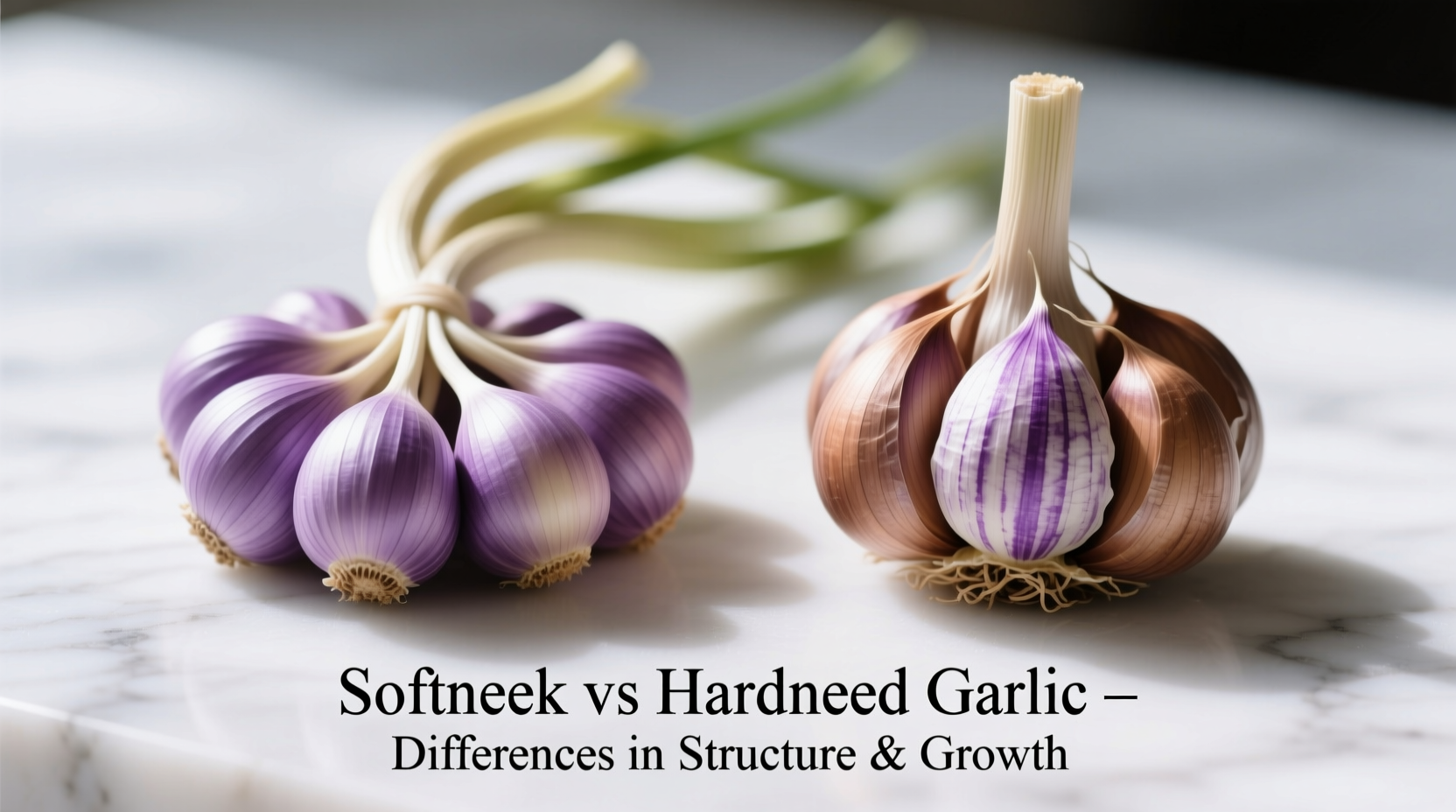Ever stood in your garden or grocery store wondering which garlic variety will deliver the best results for your cooking or growing needs? Understanding the fundamental differences between softneck and hardneck garlic varieties can transform your culinary creations and gardening success. This comprehensive guide cuts through the confusion with practical, science-backed information to help you select the perfect garlic for your specific requirements.
What Actually Defines Softneck and Hardneck Garlic?
The primary distinction lies in their physical structure and growth patterns. Softneck garlic (Allium sativum var. sativum) lacks a central flowering stalk, resulting in flexible necks that make them ideal for braiding. Hardneck garlic (Allium sativum var. ophioscorodon) develops a rigid central stalk that eventually produces a flower stalk called a scape.
| Characteristic | Softneck Garlic | Hardneck Garlic |
|---|---|---|
| Neck Structure | Flexible, soft stalks | Rigid central stalk |
| Clove Arrangement | Multiple layers of small cloves | Single ring of larger cloves |
| Storage Life | 9-12 months | 4-6 months |
| Flavor Profile | Milder, more subtle | Stronger, more complex |
| Climate Adaptation | Warmer regions | Colder climates |
Flavor Differences That Actually Matter in Your Cooking
When it comes to culinary applications, the flavor distinction between these garlic varieties significantly impacts your dishes. Hardneck garlic delivers a more intense, complex flavor profile with noticeable variations between subspecies. Rocambole varieties offer rich, earthy notes with a hint of fruitiness, while Porcelain types provide powerful, clean heat that stands up well in roasting.
Softneck varieties maintain consistent flavor throughout the year but generally offer milder taste profiles. This makes them excellent for commercial products where flavor consistency is crucial. Artichoke types provide reliable, medium-strength garlic flavor perfect for everyday cooking, while Silverskin varieties offer the mildest taste, ideal for raw applications where you don't want garlic to dominate.

Which Garlic Should You Grow? Climate and Cultivation Factors
Your geographic location plays a decisive role in which garlic variety will thrive in your garden. Hardneck garlic requires vernalization—a period of cold temperatures—to develop properly, making it the superior choice for gardeners in USDA zones 3-7. These varieties typically need 4-8 weeks below 40°F (4°C) to form proper bulbs.
Softneck garlic performs better in milder climates (zones 7-10) where winter temperatures rarely drop below freezing. Without the need for significant cold exposure, softnecks reliably produce bulbs in regions where hardnecks might fail to develop properly. Gardeners in transitional climate zones often achieve success with both types by adjusting planting schedules.
Storage Performance: How Long Will Your Harvest Last?
One of the most practical differences between these garlic types involves storage longevity. Softneck garlic's tighter wrapper leaves and lower moisture content enable storage for 9-12 months under proper conditions (60-65°F with 60-70% humidity). This extended shelf life makes softnecks the preferred choice for commercial growers and home gardeners who want garlic available year-round.
Hardneck varieties typically last only 4-6 months in storage before cloves begin to sprout or deteriorate. The exception is Porcelain types, which often store closer to 7-8 months. To maximize hardneck storage life, cure bulbs thoroughly (3-4 weeks in a well-ventilated area) and maintain consistent storage conditions. Many gardeners overcome this limitation by preserving hardneck garlic through freezing, pickling, or making garlic-infused oils.
The Braiding Advantage: Why Softneck Reigns Supreme
If you've ever admired those beautiful garlic braids hanging in kitchens, you're looking at softneck varieties. The flexible stalks of softneck garlic allow for intricate braiding that hardneck's rigid stalks simply cannot accommodate. This isn't just aesthetic—braiding promotes air circulation, extending storage life while creating attractive kitchen decor.
To create your own garlic braid, harvest softneck garlic when the lower third of leaves have turned brown. Leave stalks intact (about 6 inches above bulbs) and cure for 2-3 weeks before braiding. Start with three bulbs, weaving additional bulbs into the braid as you work downward. Hang your finished braid in a cool, dry place away from direct sunlight.
Special Varieties Worth Exploring
Within each category, specific cultivars offer unique characteristics worth considering:
Notable Softneck Varieties
- Silverskin: Longest storage (up to 12 months), very mild flavor, numerous small cloves
- Artichoke: Medium storage (8-10 months), robust flavor, larger cloves than Silverskin
Popular Hardneck Varieties
- Rocambole: Complex flavor, excellent for roasting, produces beautiful scapes
- Porcelain: Largest cloves, strongest flavor, better storage than other hardnecks
- Purple Stripe: Vibrant color, medium heat, performs well in diverse climates
Common Mistakes to Avoid with Each Type
Gardeners new to garlic cultivation often make preventable errors with these varieties. For softnecks, the most common mistake is harvesting too early—wait until at least half the leaves have browned. With hardnecks, many gardeners miss the narrow window for harvesting scapes, which should be removed when they form their first complete loop but before they straighten out.
Cooking with these varieties presents different challenges. Using hardneck garlic raw without letting it mellow can overwhelm dishes, while softneck's milder flavor sometimes disappears in long-cooking applications. Professional chefs recommend using hardneck for raw applications and finishing touches, while softneck works better in long-simmered sauces and stews.
Which Garlic Is Right for Your Specific Needs?
Your final choice depends on your primary priorities:
- Choose softneck if: You need long-term storage, want to create garlic braids, live in a warmer climate, or prefer milder garlic flavor
- Choose hardneck if: Flavor intensity is your priority, you grow in a cold climate, want to harvest scapes, or use garlic primarily raw
Many serious garlic enthusiasts maintain both types in their gardens and pantries—using hardneck for its superior fresh flavor during its season, then transitioning to softneck for extended availability. This dual approach gives you the best of both worlds throughout the year.











 浙公网安备
33010002000092号
浙公网安备
33010002000092号 浙B2-20120091-4
浙B2-20120091-4